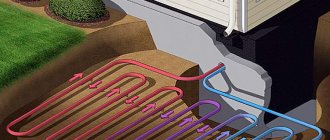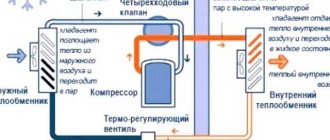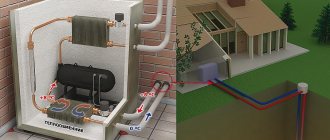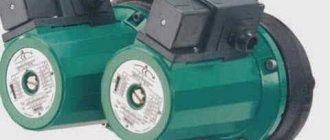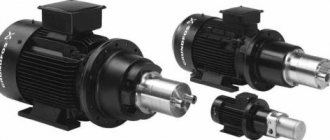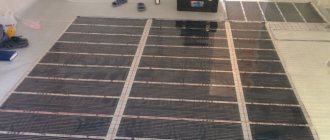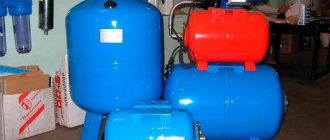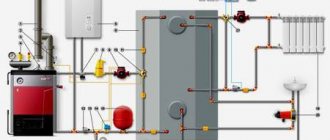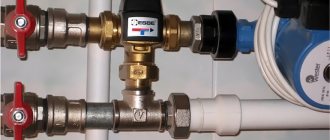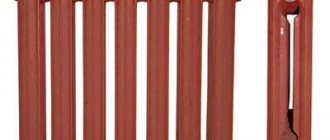Types of heat pump designs
The type of heat pump is usually denoted by a phrase indicating the source medium and coolant of the heating system.
The following varieties exist:
- TN “air-to-air”;
- HP "air - water";
- TN “soil - water”;
- TN "water - water".
The very first option is a conventional split system operating in heating mode. The evaporator is mounted outside, and a unit with a condenser is installed inside the house. The latter is blown by a fan, due to which warm air mass is supplied to the room.
If such a system is equipped with a special heat exchanger with pipes, the result is an air-water heat exchanger. It is connected to a water heating system.
A HP evaporator of the “air-to-air” or “air-to-water” type can be placed not on the street, but in the exhaust ventilation duct (it must be forced). In this case, the efficiency of the HP will be increased several times.
Heat pumps of the “water-to-water” and “ground-to-water” types use a so-called external heat exchanger or, as it is also called, a collector, to extract heat.
Schematic diagram of the operation of a heat pump
This is a long looped pipe, usually plastic, through which a liquid circulates, washing the evaporator. Both types of HP represent the same device: in one case, the collector is immersed in the bottom of a surface reservoir, and in the second - in the ground. The condenser of such a heat pump is located in a heat exchanger connected to the water heating system.
Connecting a VT according to the “water-water” scheme is much less labor-intensive than “ground-water”, since there is no need for excavation work. The pipe is laid in a spiral at the bottom of the reservoir. Of course, only a reservoir that does not freeze to the bottom in winter is suitable for this scheme.
The time has come to substantively study foreign experience
Almost everyone now knows about heat pumps capable of extracting heat from the environment to heat buildings, and if until recently a potential customer, as a rule, asked the perplexed question “how is this possible?”, Now the question “how is this correct” is increasingly heard do?".
It is not easy to answer this question.
In search of an answer to the numerous questions that inevitably arise when trying to design heating systems with heat pumps, it is advisable to turn to the experience of specialists from those countries where heat pumps on ground heat exchangers have been used for a long time.
A visit* to the American exhibition AHR EXPO 2008, which was undertaken mainly to obtain information about methods of engineering calculations of ground heat exchangers, did not bring direct results in this direction, but a book was sold at the ASHRAE exhibition stand, some of the provisions of which served as the basis for this publications.
It should be said right away that transferring American methods to domestic soil is not an easy task. For Americans, everything is not the same as in Europe. Only they measure time in the same units as we do. All other units of measurement are purely American, or rather British. Americans are especially unlucky with heat flow, which can be measured both in British thermal units per unit of time and in tons of cooling, which were probably invented in America.
The main problem, however, was not the technical inconvenience of recalculating the units of measurement adopted in the United States, to which one can get used to over time, but the absence in the mentioned book of a clear methodological basis for constructing a calculation algorithm. Too much space is devoted to routine and well-known calculation methods, while some important provisions remain completely undisclosed.
In particular, such physically related initial data for calculating vertical ground heat exchangers, such as the temperature of the liquid circulating in the heat exchanger and the conversion coefficient of the heat pump, cannot be set arbitrarily, and before proceeding with calculations related to unsteady heat exchange in the ground, it is necessary to determine the dependencies connecting these parameters.
The criterion for the efficiency of a heat pump is the conversion coefficient ?, the value of which is determined by the ratio of its thermal power to the power of the electric drive of the compressor. This value is a function of the boiling temperatures in the evaporator tu and the condensation temperatures tk, and in relation to water-to-water heat pumps, we can talk about the liquid temperatures at the outlet of the evaporator t2I and at the outlet of the condenser t2K:
? = ?(t2I,t2K). (1)
Analysis of the catalog characteristics of serial refrigeration machines and water-to-water heat pumps made it possible to display this function in the form of a diagram (Fig. 1).
Using the diagram, it is not difficult to determine the parameters of the heat pump at the very initial stages of design. It is obvious, for example, that if the heating system connected to the heat pump is designed to supply coolant with a supply temperature of 50°C, then the maximum possible conversion coefficient of the heat pump will be about 3.5. In this case, the glycol temperature at the outlet of the evaporator should not be lower than +3°C, which means that an expensive ground heat exchanger will be required.
At the same time, if the house is heated using underfloor heating, coolant with a temperature of 35°C will flow from the heat pump condenser into the heating system. In this case, the heat pump can operate more efficiently, for example with a conversion factor of 4.3, if the temperature of the glycol cooled in the evaporator is around -2°C.
Using Excel spreadsheets, you can express function (1) as an equation:
? = 0.1729 • (41.5 + t2I – 0.015t2I • t2K – 0.437 • t2K (2)
If, with the desired conversion coefficient and a given value of the coolant temperature in a heating system powered by a heat pump, it is necessary to determine the temperature of the liquid cooled in the evaporator, then equation (2) can be presented as:
(3)
You can select the coolant temperature in the heating system at given values of the heat pump conversion coefficient and the liquid temperature at the outlet of the evaporator using the formula:
(4)
In formulas (2)…(4) temperatures are expressed in degrees Celsius.
Having identified these dependencies, we can now move directly to the American experience.
Heat pump for heating water: installation in a heating system
Homemade water-to-water heat pump
When installing a heating system, it should be taken into account that the water in the condenser will only warm up to 40-50 degrees Celsius. Therefore, only a low-temperature heating system, for example, a warm floor, can act as a “consumer” of heat pump energy. Or any other volumetric radiator, the effectiveness of which is determined not by temperature, but by the overall radiation area.
Moreover, in most cases, a homemade heat pump can only be used as an auxiliary energy source that supports the operation of an electric or gas boiler.
Full heating and heating is guaranteed only by highly efficient “factory” units that heat the condenser to 75 degrees Celsius and higher.
Homemade pumps cannot provide such a temperature due to design flaws and unbalanced compressor operation.
However, only a “crazy” unit can demonstrate effective results, but a Chinese-made water-water heat pump differs from a high-quality homemade product only in a more sophisticated pump control automation system.
Calculation method for heat pumps
Of course, the process of selecting and calculating a heat pump is a very technically complex operation and depends on the individual characteristics of the object, but roughly it can be reduced to the following steps:
Heat loss through the building envelope (walls, ceilings, windows, doors) is determined. This can be done by applying the following relationship:
Qok = S*( tin – tout)* (1 + Σ β ) *n / Rt(W) where
tout – outside air temperature (°C);
tin – internal air temperature (°C);
S – total area of all enclosing structures (m2);
n – coefficient indicating the influence of the environment on the characteristics of the object. For rooms in direct contact with the outside environment through ceilings n=1; for objects with attic floors n=0.9; if the object is located above the basement n = 0.75;
β – coefficient of additional heat loss, which depends on the type of structure and its geographical location β can vary from 0.05 to 0.27;
Rt – thermal resistance, determined by the following expression:
Rt = 1/ αint + Σ ( δі / λі ) + 1/ αout (m2*°C / W), where:
δі / λі – calculated indicator of thermal conductivity of materials used in construction.
αout – coefficient of thermal dissipation of external surfaces of enclosing structures (W/m2*оС);
αinternal – thermal absorption coefficient of internal surfaces of enclosing structures (W/m2*оС);
— The total heat loss of the structure is calculated using the formula:
Qt.pot = Qok + Qi – Qbp, where:
Qi is the energy consumption for heating the air entering the room through natural leaks;
Qbp - heat generation due to the functioning of household appliances and human activities.
2. Based on the data obtained, the annual consumption of thermal energy is calculated for each individual object:
Qyear = 24*0.63*Qt. sweat.*(( d*( tin - tout.av.)/ ( tin - tout.))(kW/hour per year.) where:
tin – recommended indoor air temperature;
tout – outside air temperature;
tout.av – arithmetic mean value of the outside air temperature for the entire heating season;
d – number of days of the heating period.
3. For a complete analysis, you will need to calculate the level of thermal power required to heat the water:
Qgv = V * 17 (kW/hour per year) where:
V – volume of daily heating of water up to 50 °C.
Then the total consumption of thermal energy will be determined by the formula:
Q = Qgv + Qyear (kW/hour per year.)
Taking into account the data obtained, choosing the most suitable heat pump for heating and hot water supply will not be difficult. Moreover, the calculated power will be determined as: Qтн=1.1*Q, where:
Qтн=1.1*Q, where:
1.1 – correction factor indicating the possibility of increasing the load on the heat pump during the period of critical temperatures.
After calculating heat pumps, you can select the most suitable heat pump that can provide the required microclimate parameters in rooms with any technical characteristics. And given the possibility of integrating this system with a heated floor climate control system, one can note not only its functionality, but also its high aesthetic value.
Types of Heat Pumps
Heat pumps are divided into three main types based on the source of low-grade energy:
- Air.
- Priming.
- Water - the source can be groundwater and surface water bodies.
For water heating systems, which are more common, the following types of heat pumps are used:
Air-to-water is an air-to-air heat pump that heats a building by drawing in air from outside through an external unit. It works on the principle of an air conditioner, only in reverse, converting air energy into heat. Such a heat pump does not require large installation costs; there is no need to allocate a plot of land for it and, especially, to drill a well. However, operating efficiency at low temperatures (-25ºС) is reduced and an additional source of thermal energy is required.
The “ground-water” device is a geothermal device and extracts heat from the ground using a collector placed at a depth below freezing of the soil. There is also a dependence on the area of the site and the landscape if the collector is located horizontally. For a vertical location, you will need to drill a well.
“Water-water” is installed where there is a pond or groundwater nearby. In the first case, the collector is laid on the bottom of the reservoir, in the second, a well or several are drilled, if the area of the site allows. Sometimes the depth of groundwater is too great, so the cost of installing such a heat pump can be very high.
Each type of heat pump has its own advantages and disadvantages; if the building is located far from a body of water or the groundwater is too deep, then “water-to-water” will not work. “Air-water” will be relevant only in relatively warm regions, where the air temperature in the cold season does not fall below -25º C.
Heat pump. House heating design
In a home heating system, a heat pump (HP) plays the same role as a boiler, that is, it is a heat generator.
The only difference is that the boiler burns fuel, and the heat pump “pumps out” thermal energy from sources that, at first glance, are not rich in it at all.
Soil and river water with a temperature of 5 - 7 degrees, or even frosty winter air, the temperature of which was generally below zero.
Such sources are called low-potential, and although they are in no way associated with the concept of heat, TN manages to “squeeze” an impressive amount of life-giving energy out of them. To this should be added the heat generated by the electric motor of the HP compressor: here, unlike a refrigerator and air conditioner, it is not wasted.
Otherwise, a heating system based on a heat pump is no different from a conventional one: a coolant is used - water or air, which is heated by flowing through a heat exchanger, and then distributes heat throughout the house. Circulation is provided by a pump (for water heating) or a fan (for air heating). Just like a traditional heat generator, a HP can be simultaneously connected to a hot water supply (DHW) circuit with or without a storage tank (boiler).
Did you know that you can heat your home for next to nothing? Geothermal heating: operating principle, advantages and disadvantages of technology, read carefully.
Read about how to independently install a double-circuit gas boiler for heating a private home.
In Russia, steam heating appeared earlier than water heating, but now such a system is rarely used. Here https://microklimat.pro/sistemy-otopleniya/montazh-sistem-otopleniya/parovoe-otoplenie-v-chastnom-dome-sxema.html you will find an overview of the main types of boilers and methods of steam heating.
Method for calculating heat pump power
In addition to determining the optimal energy source, you will need to calculate the heat pump power required for heating. It depends on the amount of heat loss from the building. Let's calculate the power of a heat pump for heating a house using a specific example.
To do this, we use the formula Q=k*V*∆T, where
- Q is heat loss (kcal/hour). 1 kW/h = 860 kcal/h;
- V is the volume of the house in m3 (the area is multiplied by the height of the ceilings);
- ∆T – the ratio of the minimum temperatures outside and inside the room during the coldest period of the year, °C. From the internal tº we subtract the external one;
- k is the generalized heat transfer coefficient of the building. For a brick building with masonry in two layers k=1; for a well-insulated building k=0.6.
Thus, the calculation of the heat pump power for heating a brick house of 100 sq.m and a ceiling height of 2.5 m, with a ttº difference from -30º outside to +20º inside, will be as follows:
Q = (100x2.5) x (20- (-30)) x 1 = 12500 kcal/hour
12500/860= 14.53 kW. That is, for a standard brick house with an area of 100 m, you will need a 14-kilowatt device.
The consumer makes the choice of the type and power of the heat pump based on a number of conditions:
- geographical features of the area (proximity of reservoirs, presence of groundwater, free land for a collector);
- climate features (temperature);
- type and internal volume of the room;
- financial opportunities.
Taking into account all the above aspects, you can make the optimal choice of equipment. For a more efficient and correct selection of a heat pump, it is better to contact specialists; they will be able to make more detailed calculations and provide the economic feasibility of installing the equipment.
Heat pumps have been used for a long time and very successfully in domestic and industrial refrigerators and air conditioners.
Today, these devices have begun to be used to perform the opposite function - heating a home during cold weather.
Let's look at how heat pumps are used to heat private homes and what you need to know in order to correctly calculate all its components.
Calculation formula
Ways of heat loss in the house
The heat pump is able to completely cope with space heating.
To choose the unit that suits you, you should calculate its required power.
First of all, you need to understand the heat balance in the building. For these calculations, you can use the services of specialists, an online calculator, or yourself using a simple formula:
R=(kx V x T)/860 , in which:
R is the power consumption of the room (kW/hour); k is the average heat loss coefficient of the building: for example, equal to 1 - a well-insulated building, and 4 - a barracks made of boards; V is the total volume of the entire heated room, in cubic meters; T is the maximum temperature difference between the street and indoors. 860 is the value required to convert the resulting kcal to kW.
In the case of a water-to-water geothermal heat pump, you also need to calculate the required length of the circuit that will be located in the reservoir. Here the calculation is even simpler.
It is known that 1 meter of collector produces approximately 30 W. In other words, 1 kW of pump power requires 22 meters of pipes. Knowing the required pump power, we can easily calculate how many pipes we need to make the circuit.
Example of heat pump calculation
We will select a heating element for the heating system of a one-story house with a total area of 70 square meters. m with a standard ceiling height (2.5 m), rational architecture and thermal insulation of enclosing structures that meet the requirements of modern building codes. For heating the 1st sq. m of such an object, according to generally accepted standards, it is necessary to spend 100 W of heat. Thus, to heat the entire house you will need:
Q = 70 x 100 = 7000 W = 7 kW of thermal energy.
We choose a heat pump of the TeploDarom brand (model L-024-WLC) with a thermal power W = 7.7 kW. The compressor of the unit consumes N = 2.5 kW of electricity.
Reservoir calculation
The soil in the area allocated for the construction of the collector is clayey, the groundwater level is high (we assume the calorific value p = 35 W/m).
The collector power is determined by the formula:
Qk = W – N = 7.7 – 2.5 = 5.2 kW.
L = 5200 / 35 = 148.5 m (approx.).
Based on the fact that laying a circuit longer than 100 m is irrational due to excessively high hydraulic resistance, we accept the following: the heat pump collector will consist of two circuits - 100 m and 50 m long.
The area of the site that will need to be allocated for the collector will be determined using the formula:
S = L x A,
Where A is the step between adjacent sections of the contour. We accept: A = 0.8 m.
Then S = 150 x 0.8 = 120 sq. m.
Homemade heat pump: assembly diagram
The above operating diagram indicates that the heat pump design consists of four units: evaporator, condenser, compressor and cyclic pipeline. Therefore, the process of self-building a heat pump consists of manufacturing all the above-mentioned components and then assembling the structure.
And further in the text we will consider all stages of the production and assembly processes carried out with our own hands. Moreover, first, recommendations will be given on system calculations aimed at optimizing energy consumption and enhancing heat transfer.
Stage one: calculating the water-water heat pump
The pump calculation is performed using a special “calculator” - a program that compares the heated area with the power of the heating system. Moreover, the program uses the volume of the room (area and ceiling height) as initial data. And at the output a recommendation is given regarding the pump power.
Stage two: choosing a compressor
The compressor for the heat pump is selected according to the expected power of the heating system. Moreover, the power of the compressor itself should be 20-30 percent of the heat output of the pump.
Heat pump with screw compressor
That is, if it takes 10 kW to heat a building, then a 3-kilowatt compressor is used to service the pump. In short, the proportion between the power of the injection equipment and the heat transfer of the pump is calculated according to the ratio 1:3.
Moreover, both standard units for split systems and special equipment are used as a compressor for a heat pump. And only a “factory” compressor will have to be integrated into a homemade system, since “homemade” analogues are inappropriate in this case - they will jeopardize the very efficiency of the assembled pump.
Stage three: construction of the evaporator
The evaporator is assembled on the basis of a polymer tank with a large lid. Moreover, the minimum tank capacity is 120-130 liters. A copper coil bent from a pipe of a certain length and diameter is placed in the internal cavity of the tank.
Evaporator for water-to-water heat pump
To determine these values, we will have to calculate the surface area of the coil.
As a rule, it is calculated using the formula:
Р=M/0.8ΔT,
where M is the expected pump power, and ΔT is the temperature difference between the inlet and outlet (in degrees Celsius).
The resulting area is compared with the area of one linear meter of pipe of the required diameter, calculating the length of the workpiece for the coil.
Well, the very manufacture of the evaporator core involves manual bending of a copper pipe around a gauge, which can be used as an oxygen or gas cylinder. The coil made in this way is placed in a barrel, with two outlets coming out through the bottom and lid - upper and lower.
Next, you need to install a pair of bends made of metal fittings into the barrel - they are inserted into the holes at the bottom and lid and pressed in from the outside and inside with locknuts.
A pump pressure hose is mounted to the lower fitting, and a discharge hose is installed to the upper fitting, through which the water will drain into the well by gravity. With this design we will ensure continuous circulation of a low-efficiency medium in the evaporator.
Stage four: creating a capacitor
The condenser is assembled on the basis of a metal tank made of stainless steel, into which a copper coil is mounted, calculated according to the same formulas as a similar part of the evaporator. Moreover, the same manual bending technology is used to manufacture the coil.
The coil itself is placed vertically in the tank, and its outlets come out of the bottom and lid of the tank. Moreover, in addition to the taps, two fittings are also cut into the tank. In a word, the entire circuit is copied from the evaporator, only taking into account the fact that instead of a low-efficiency medium, heated water circulates through the condenser - the coolant of the heating system . Using a special pump, it is removed through the upper fitting, directed to the radiators, and introduced into the tank through the lower fitting connected to the return line.
Stage five: assembly work
The system is assembled in the following order:
Principle of operation
- The compressor is mounted on a platform or bracket.
- The upper outlet of the condenser is connected to the compressor discharge pipe (with a copper pipe).
- The lower outlet of the condenser is connected to the lower outlet of the evaporator by laying a copper pipeline between them, the diameter of which must match the dimensions of the tubes used in the manufacture of the coils. Moreover, in any place in this pipeline you can mount a throttle valve, which is connected to the automatic control system.
- The upper outlet of the evaporator is connected (with a copper tube) to the suction pipe of the compressor. Installation work with copper pipes is carried out using soldering, and finally refrigerant (about a couple of kilograms) is poured into the system.
The result is a closed system in which a refrigerant circulates, transferring heat from an evaporator barrel installed on the ground to a tank with a condenser suspended on a bracket.
Payback of a heat pump
When it comes to how long it will take for a person to get back his money invested in something, we mean how profitable the investment itself was. In the heating sector, everything is quite difficult, since we provide ourselves with comfort and warmth, and all systems are expensive, but in this case, you can look for an option that would return the money spent by reducing costs during use. And when you start looking for a suitable solution, you compare everything: a gas boiler, a heat pump or an electric boiler. We will analyze which system will pay off faster and more efficiently.
The concept of payback, in this case, the introduction of a heat pump to modernize the existing heat supply system, simply put, can be explained as follows:
There is one system - an individual gas boiler, which provides autonomous heating and hot water. There is a split-system air conditioner that provides cold air to one room. 3 split systems installed in different rooms.
And there is a more economical advanced technology - a heat pump, which will heat / cool houses and heat water in the right quantities for a house or apartment. It is necessary to determine how much the total cost of equipment and initial costs has changed, and also to estimate how much the annual costs of operating the selected types of equipment have decreased. And determine how many years it will take for more expensive equipment to pay for itself with the resulting savings. Ideally, several proposed design solutions are compared and the most cost-effective is selected.
We will carry out calculations and find out what is the payback period for a heat pump in Ukraine
Let's look at a specific example
- The house has 2 floors, is well insulated, with a total area of 150 sq. m.
- Heat distribution/heating system: circuit 1 – heated floor, circuit 2 – radiators (or fan coils).
- A gas boiler for heating and hot water supply (DHW) has been installed, for example 24 kW, double-circuit.
- Split air conditioning system for 3 rooms of the house.
Annual heating and water heating costs
| Max. heat output of HP for heating, kW | 19993,59 |
| Max. power consumption of the heat pump when operating for heating, kW | 7283,18 |
| Max. heating capacity of the heating element for domestic hot water supply, kW | 2133,46 |
| Max. HP power consumption when operating on DHW, kW | 866,12 |
- The approximate cost of a boiler room with a 24 kW gas boiler (boiler, piping, wiring, tank, meter, installation) is about 1000 Euros. An air conditioning system (one split system) for such a house will cost about 800 euros. In total, including the installation of the boiler room, design work, connection to the gas pipeline network and installation work - 6,100 euros.
- The approximate cost of a Mycond heat pump with an additional fan coil system, installation work and connection to the electrical network is 6,650 euros.
- The growth of capital investments is: K2-K1 = 6650 – 6100 = 550 euros (or about 16500 UAH)
- The reduction in operating costs is: C1-C2 = 27252 – 7644 = 19608 UAH.
- Payback period Tokup. = 16500 / 19608 = 0.84 years!
Ease of use of the heat pump
Heat pumps are the most versatile, multifunctional and energy-efficient equipment for heating a home, apartment, office or commercial facility.
An intelligent control system with weekly or daily programming, automatic switching of seasonal settings, maintaining the temperature in the house, economical modes, control of a slave boiler, boiler, circulation pumps, temperature control in two heating circuits, is the most advanced and advanced. Inverter control of the compressor, fan, and pumps allows for maximum energy savings.
Heat pump operation when working according to the ground-water scheme
The collector can be installed in the ground in three ways.
Horizontal option
The pipes are laid in trenches in a “snake” pattern to a depth exceeding the freezing depth of the soil (on average, from 1 to 1.5 m).
Such a collector will require a fairly large plot of land, but any homeowner can build it - no skills other than the ability to work with a shovel will be required.
It should, however, be taken into account that constructing a heat exchanger manually is a rather labor-intensive process.
Vertical option
Collector pipes in the form of loops shaped like the letter “U” are immersed in wells with a depth of 20 to 100 m. If necessary, several such wells can be built. After installing the pipes, the wells are filled with cement mortar.
The advantage of a vertical collector is that its construction requires a very small area. However, there is no way to drill wells more than 20 m deep on your own - you will have to hire a team of drillers.
Combined option
This collector can be considered a type of horizontal, but its construction will require much less space.
A round well with a depth of 2 m is dug on the site.
The heat exchanger pipes are laid in a spiral, so that the circuit looks like a vertically installed spring.
Upon completion of installation work, the well is backfilled. As in the case of a horizontal heat exchanger, all the necessary work can be done with your own hands.
The collector is filled with antifreeze - antifreeze or ethylene glycol solution. To ensure its circulation, a special pump is inserted into the circuit. Having absorbed the heat of the soil, the antifreeze enters the evaporator, where heat exchange occurs between it and the refrigerant.
It should be taken into account that unlimited heat extraction from the ground, especially when the collector is located vertically, can lead to undesirable consequences for the geology and ecology of the site. Therefore, in the summer, it is highly desirable to operate HPs of the “soil-water” type in reverse mode - air conditioning.
A gas heating system has a lot of advantages and one of the main ones is the low cost of gas. The heating diagram for a private house with a gas boiler will tell you how to arrange heating of your home with gas. Let's consider the heating system design and replacement requirements.
Read about the features of choosing solar panels for heating your home in this topic.
How does a ground source heat pump work? Principle of operation.
To obtain heat from the ground, a ground heat exchanger is needed. To do this, simply place a pipe in the ground, forming a loop in which a liquid circulates - popularly called brine. The loop (in practice there are several) passes through the heat pump's evaporator, where the brine temperature decreases and becomes lower than the ground temperature. As the brine passes further through the pipe in the ground, it gradually heats up. At the end it goes back to the evaporator, where it gives off heat.
Thus, the brine mediates the exchange of temperature differences between the soil and the pump evaporator.
The heat exchanger can be horizontal or vertical. The size of the land plot helps in choosing a solution - several hundred square meters are required for the manufacture of a horizontal heat exchanger, and several dozen are enough for vertical probes.
It is important that the volume of the heat exchanger is large - for the entire heating season, the pump receives several megawatt-hours of heat from the ground. If it is too small, it is subject to excessive cooling and, as a result, the pump cannot operate correctly. The control system of a ground source heat pump usually switches it off when the brine temperature drops to -7°C, because below this value the circuit is excessively disrupted.
Ground source heat pump with horizontal heat exchanger.
In the case of a heat exchanger made of pipes located horizontally, the optimal depth is 0.2 - 0.5 m below the freezing line. However, if there is a watercourse at a relatively shallow depth, then the best solution is to place the pipes in it. The heat pump then achieves a higher performance coefficient Kp .
The pipes of the horizontal heat exchanger are laid in a pre-prepared pit with dimensions corresponding to the required surface of the heat exchanger. They are led in the form of a coil (in bends) over the entire surface of the pit, maintaining certain intervals between adjacent sections. Intervals should not be less than 0.4 m and no more than 1.2 m, taking into account the type of soil from which its ability to “regenerate” (adding heat) derives. The longer the ground surface is frozen, the longer the interval should be.
It must be remembered that the thermal power of the heat exchanger does not flow from the length of the pipe, only from the surface of the soil on which it is laid. Small gaps do not allow receiving more heat from it, due to the need to use a long pipe. This translates into higher investment costs as well as operating costs, because in order to pump brine through a long pipe, a circulation pump with more power is needed. Because of this too large gap between the pipes, the heat does not flow in the designed amount, so the heat exchanger output is less.
Ground heat exchanger project.
Designing the appropriately sized ground heat exchanger is key to proper heat pump operation. To calculate its required value, information about the required power of the heat pump is required. If it is not in the technical characteristics of the device, then it is enough to know that it corresponds to the thermal power reduced by the compressor power. If we do not know what power the compressor has, but we have information about the performance coefficient Kp , then we can calculate the cooling power with sufficient accuracy using the formula:
Qcool = (Kp – 1)/Kp • Qheat.
It is necessary to pay attention that the substituted values are achieved at a temperature corresponding to that prevailing both in the soil and in the heating system when the pump is operating at full power (for example, 0/35 - brine temperature 0 degrees Celsius, heating system 35 degrees Celsius).
Calculation of the heat exchanger surface of a horizontal ground source heat pump.
The force with which a ground heat exchanger transfers heat depends on the type of soil, namely its moisture content. Depending on this, to calculate the surface of a horizontal heat exchanger, the following values of the thermal power of the soil qg (for polyethylene pipes) are taken:
- sandy dry – 10 W/m2
- sandy, wet – 15-20 W/m2
- clayey dry – 20-25 W/m2
- clayey, wet – 25-30 W/m2
- wet (water-bearing) – 35-40 W/m2.
Of course, these are indicative values.
It is difficult to assess whether the soil is the same throughout the area intended for the heat exchanger until construction begins, so it is better to take a lower value for calculation. In a properly designed system, the heat pump compressor runs from 1800 to 2400 hours per year, the ground heat output results in longer operating hours.
The surface of the heat exchanger is calculated using the formula:
A = Q/qg
Example: the energy requirement of a house for heating is 14 kW, and the pump will satisfy them in full (must operate in a monovalent system). The selected device receives a thermal power (heating) of 14 kW for parameters 0/35, while achieving an efficiency coefficient Kp = 4.5. The cooling power is therefore Qcool = (4.5-1)/4.5 • 14 = 10.9 kW, that is, 10900 W. The heat exchanger must be made in dry clay soil, so its area must be A = 10 900/20 = 545 m2. Attention is drawn to the fact that in the case of aquiferous soil, the heat exchanger can be half as large, but if the soil is sandy, then its area will occupy more than 1000 m2. In such a situation, the best solution is to place the pipes vertically.
Heat exchanger of a vertical ground source heat pump.
The heat pump achieves a higher performance coefficient Kp when the heat exchanger tubes are located vertically in the ground - at a depth of 40-150 m. This is due to the fact that at a depth below 10 m the ground temperature is approximately 10 degrees Celsius all year round - that is, in winter almost ten more than at a depth of 1.5 meters.
Making a vertical heat exchanger, however, is clearly more expensive than a horizontal one. These are vertical sections of pipe that form a loop (the pipe passes down through the holes, at the bottom it turns around and goes up). They are called geothermal probes. In this case, they are calculated not by area, but by the total length of the heat exchanger, which usually consists of more than one probe.
In vertical wells, one or two pairs of pipes (U or Y type probes) are placed. The insertion of the well pipe is facilitated by a head - an element connecting the vertical pipes, which can be adapted to use an additional filling pipe. The head is pushed into the holes, and with it the heat exchanger pipes. Then liquid concrete is poured into the well.
In a Y-type heat exchanger, liquid flows down to the head in one pipe and returns from it in the other. In a double U type heat exchanger, it flows with two pipes down and two up.
The distance between drilling points up to 50 m deep should not be less than 5 m, and in the case of deeper ones, from 8 to 15 meters. Must be located on a line perpendicular to the direction of water flow.
Calculation of the length of the heat exchanger of a vertical ground source heat pump.
In this case, it is important how the properties of the soil change with depth. Geological maps and documentation of wells previously drilled nearby can provide information. On this basis, it is possible to estimate the thickness of individual soil layers and calculate the average thermal conductivity coefficient for the area in which the heat exchanger tubes should be placed.
Calculations, however, are not able to take into account all movements of groundwater and in practice it often happens that the obtained result differs significantly from reality. To be sure that the vertical heat exchanger will work properly, it is necessary to carry out a soil survey in the area where drilling is to be done. In this case, the soil heat productivity qg also depends on its type.
For PE80 pipes it is:
- dry sandy soil – 10-12 W/m;
- sandy wet – 12-16 W/m;
- medium clay dry – 16-18 W/m;
- medium clay wet – 19-21 W/m;
- heavy clay dry – 18-19 W/m;
- heavy clayey wet – 20-22 W/m;
- wet (water-bearing) – 25-30 W/m.
It is necessary to take into account the thickness of individual layers of a certain type of soil and on this basis calculate the overall performance of each probe.
The heat production of soil, in which both layers are dry, like aquifers, when using double U type probes (four pipes in a well), averages about 50 W/m. Tentatively, it can be assumed that in the case of the applicants’ heat pump in the example of calculating a horizontal heat exchanger (with a cooling capacity of 10.9 kW), holes with a total length of L = 10,900/50 = 218 m are required, that is, for example, four 55 meters each.
Calculation of a horizontal heat pump collector
The efficiency of a horizontal collector depends on the temperature of the medium in which it is immersed, its thermal conductivity, and the area of contact with the surface of the pipe. The calculation method is quite complex, so in most cases averaged data is used.
It is believed that each meter of heat exchanger provides the HP with the following thermal power:
- 10 W – when buried in dry sandy or rocky soil;
- 20 W – in dry clay soil;
- 25 W – in wet clay soil;
- 35 W – in very damp clay soil.
Thus, to calculate the length of the collector (L), the required thermal power (Q) should be divided by the calorific value of the soil (p):
L = Q/p.
The values given can only be considered valid if the following conditions are met:
- The area of land above the sewer is not developed, shaded or planted with trees or bushes.
- The distance between adjacent turns of the spiral or sections of the “snake” is at least 0.7 m.
Operating principle of heat pumps
Any HP contains a working medium called refrigerant. Usually freon acts in this capacity, less often ammonia. The device itself consists of only three components:
The evaporator and condenser are two reservoirs that look like long curved tubes - coils. The condenser is connected at one end to the outlet pipe of the compressor, and the evaporator is connected to the inlet pipe. The ends of the coils are joined and a pressure reducing valve is installed at the junction between them. The evaporator is in contact – directly or indirectly – with the source medium, and the condenser is in contact with the heating or hot water system.
Working principle of a heat pump
The operation of HP is based on the interdependence of gas volume, pressure and temperature. Here's what happens inside the unit:
- Ammonia, freon or other refrigerant, moving through the evaporator, is heated from the source medium, say, to a temperature of +5 degrees.
- After passing through the evaporator, the gas reaches the compressor, which pumps it into the condenser.
- The refrigerant pumped by the compressor is held in the condenser by a pressure reducing valve, so its pressure here is higher than in the evaporator. As is known, with increasing pressure the temperature of any gas increases. This is exactly what happens to the refrigerant - it heats up to 60 - 70 degrees. Since the condenser is washed by the coolant circulating in the heating system, the latter also heats up.
- Through the pressure reducing valve, the refrigerant is discharged in small portions into the evaporator, where its pressure drops again. The gas expands and cools, and since part of the internal energy was lost by it as a result of heat exchange at the previous stage, its temperature drops below the original +5 degrees. Following the evaporator, it is heated again, then pumped into the condenser by the compressor - and so on in a circle. Scientifically, this process is called the Carnot cycle.
But HP still remains very profitable: for every kWh of electricity spent, you can get from 3 to 5 kWh of heat.
How does a heat pump work?
Any heat pump consists of an evaporator, a condenser, an expander that reduces pressure, and a compressor that increases pressure.
All these devices are connected into one closed loop by a pipeline. A refrigerant, an inert gas with a very low boiling point, circulates through the pipes, so in one part of the circuit, cold, it is a liquid, and in the second, warm, it turns into a gaseous state.
Moving further, the gas moves to the compressor, where it is compressed under the influence of high pressure, and its temperature rises. Once hot, the gas enters the condenser, which is also a heat exchanger. It transfers heat from hot gas to the coolant of the return pipeline included in the heating system of the house. Having given off heat, the gas cools and turns into a liquid state again, while the heated coolant enters the hot water supply and heating system. Passing through the pressure reducing valve of the expander, the liquefied gas again enters the evaporator - the cycle is closed.
